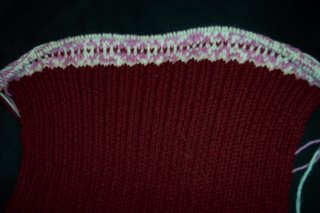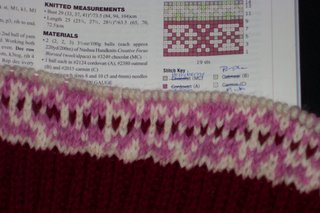What we have here is a failure to communicate...
Or at least understand what the bugger they're talking about.
Beg chart: After reading this pattern, I realized that the best code breakers in the world make some pretty neat knitted items; that is if they know math. What I like about knitting, specifically fair isle, is the challenge of detail that becomes a pattern. Knitting with one color...zzzzz...boring. Give me two or three colors and the fun begins. Give me 5 (yes 5) and I'll be ecstatic.
For those of you who normally read this, you'll notice something is off in the writing. You would be correct. Tonight's guest author is (drum roll please) Mr. CygKnit. Why? Because tonight we are going to talk about knitting math, which is really nothing more than pattern recognition. Please note that I was NOT an English major and have a horrible time writing narrative papers on which I know nothing about. (That would be most of the papers I have ever written). Shall we start then?
My wife started a fair isle sweater not too long ago. The first 13.5 inches went just fine, because it was one color. When it came time to start the extra colors, she started just fine. She asked me if it mattered how she read the chart, and I being the all naive ex-math teacher, looked at the chart and said "No, because the chart is symmetrical, it won't matter" (Notice I did not read the directions, but hey, I'm a man!) She became a little lost repeating the pattern within the pattern so often, but we circumvented that with some stitch markers (mark each time you finish the pattern, then check it, then move on to the repeat). Simple enough, she did just fine.
9 rows later at what was to be the completion of this particular motif, she asked me to take a look, which I did. Hhhhmmmm...something is just not quite right, but what is it? She checked the more complicated rows with me and it was fine, so what happened?


These two pictures show what she showed me. While it kind of looks like a pattern, it kind of doesn't at the same time. (Never mind the fact that she chose different colors. I think it looks like a hot librarian sweater with these)
I'll tell you what happened. You see, knitting patterns have the dubious honor of being read from left to right AND right to left, just as one knits. However, I have noticed, most pattern editors leave this seemingly small detail out. Ooops.

You can see the chart above that we followed. Being a symmetrical chart, it is irrelevant which way it is read. 5 stitches in from the left or right is still the same color, which is just dandy (and simple). Let me show you the kicker and why directionality became an issue.
 Above are the directions we followed. I'll type them out so you can follow along. Begin with stitch 1, work 19 stitches of chart (5) times. (We were working on the largest size, thus the "5"). Then work stitches 1-7. Continue in pattern as established, repeat rows 1-14...blah blah blah.
Above are the directions we followed. I'll type them out so you can follow along. Begin with stitch 1, work 19 stitches of chart (5) times. (We were working on the largest size, thus the "5"). Then work stitches 1-7. Continue in pattern as established, repeat rows 1-14...blah blah blah.We worked till row 9, which completed this particular colored pattern, which is when we noted the mistake.
As I said above after the picture of the chart, it does not matter how you read the chart, whether from left to right, or right to left, because it is symmetrical. Fold it in half and it is completely identical. BUT, where the editor (or uneducated knitter, whoever you choose to blame) screwed up is where it says "Then work stitches 1-7". What we have really is the chart repeated 5 times, and then a portion of the chart. What this means is, depending on which way the first row is knit, the "portion of the chart" must ALWAYS be on one particular side. In our case, our first row of the chart was knitted left to right, so the "portion" must always be on the right.
The best illustration I can think of would be brick laying. Imagine each row of the chart is a brick. The directions tell us to repeat the chart 5 times, or in this case lay 5 bricks. Then, knit 1-7, or lay a half brick. In order for the chart to line up completely, when laying the next row, the half brick must be laid on the half brick below, otherwise we get a traditional looking brick wall (meaning, the pattern within each row is askew to the row above and below). Good for brick walls, bad for knitting.
The remedy? Easier directions. From left to right, chart 5 times, then stitches 1-7. From right to left, stitches 7-1, then chart 5 times. Suddenly, it all makes sense. Notice I reversed the stitches in the "portion" too? Looking at the first row of this pattern, we can see that stitch number 7 will be the last stitch in the row. Much as the portion must line up with the portion in the next row, the stitches within in the portion must also line up. In other words, stitch number 7 will end the left to right rows, and start the right to left rows. Ta-da!
We'll show you this when we're less frustrated and have completed the ripping and restitching of this pattern.
[For the record, Mr. CygKnit made me dinner and poured me a nice drink before writing this.]








7 Comments:
My local knitting friends and I have often complained that knitting patterns are really a secret code created by a secret society with the singular intention of keeping the rest of us out. There are countless times while learning to knit that I've come across just such an omission. Which side of the work to hold the yarn while slipping stitches is another pet peeve. Argh!
Some knitting patterns can be quite confusing. I like when the directions are clear and everything is spelled out for me.
First, I'm on cough medicine so I'm a little loopier than usual and this might not make sense...
If you're knitting in the round, you read the chart from left to right on every row, since that is the way you are knitting. If you were turning the work, on the WS rows you would read the chart from right to left.
Of course, you might have already said that in your post - I just skimmed it ;o)
It's a lovely FUBAR if I do say so myself, and I do. So what if the pattern isn't what you thought it soud be. I still like it.
:)
I have done the same kind of thing myself, and am always left wondering why I did not pick up the problem on row 2 instead of doggedly continuing on in the hopes that at some point it would all come together nicely.
The idea of two of you struggling through this together is too funny. Yeah, blame the designer.... :-)
That was a hard lesson learned, especially on a poorly written pattern. Whew. Good for you two for working it out. Your actual knitted pattern was intriguing in itself; kind of reminded me of the "Fair Isle" designs one gets from the self striping sock yarns.
How cute are the two of you? Too damn cute; you make me want to puke.
But that's me.
I love the color modification. It will look great on you. Not Mr. Cygknit; I mean Mrs. Cygknit.
Good luck with the rest of the Fair Isle; you will get the hang of it, I promise. I only ever Fair Isled one thing, and it came out great, so just remember, deep breaths and call me often.
Post a Comment
<< Home